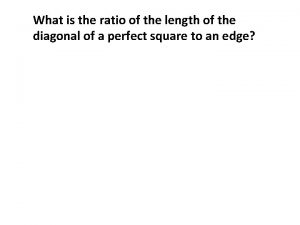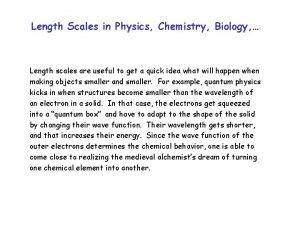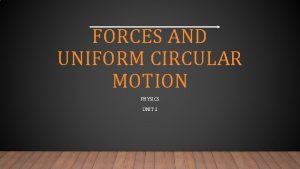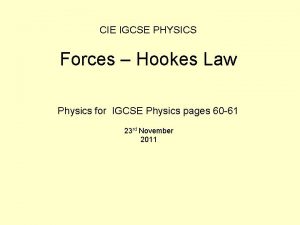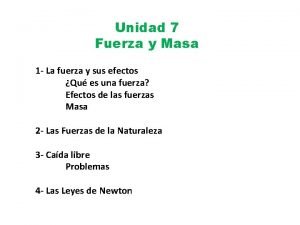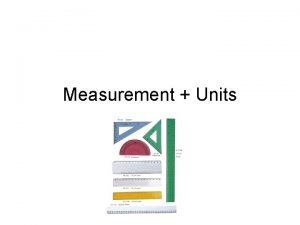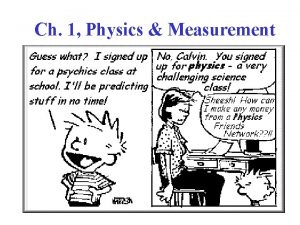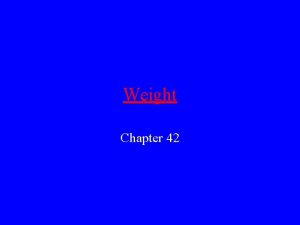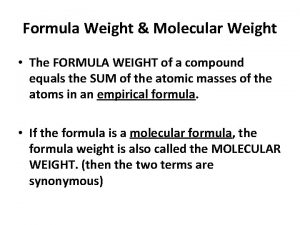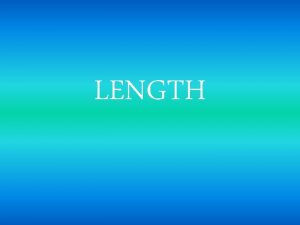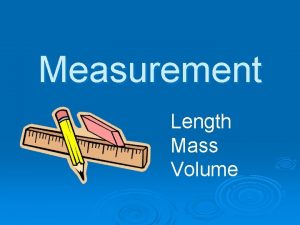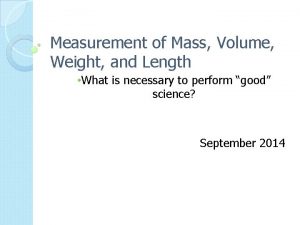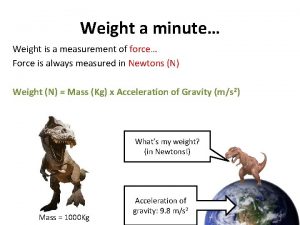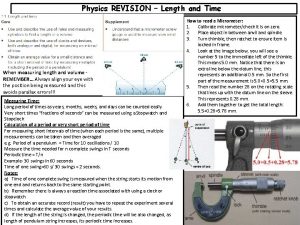Physics is the Science of Measurement Length Weight






















































- Slides: 54

Physics is the Science of Measurement Length Weight Time We begin with the measurement of length: its magnitude and its direction.

Distance: A Scalar Quantity § Distance is the length of the actual path taken by an object. s = 20 m A B A scalar quantity: Contains magnitude only and consists of a number and a unit. (20 m, 40 mi/h, 10 gal)

Displacement—A Vector Quantity • Displacement is the straight-line separation of two points in a specified direction. D = 12 m, 20 o A B A vector quantity: Contains magnitude AND direction, a number, unit & angle. (12 m, 300; 8 km/h, N)

Distance and Displacement • Displacement is the x or y coordinate of position. Consider a car that travels 4 m, E then 6 m, W. D Net displacement: 4 m, E x = -2 x = +4 6 m, W D = 2 m, W What is the distance traveled? 10 m !!

Identifying Direction A common way of identifying direction is by reference to East, North, West, and South. (Locate points below. ) Length = 40 m N 40 m, 50 o N of E W 60 o 50 o 60 o E 40 m, 60 o N of W 40 m, 60 o W of S S 40 m, 60 o S of E

Identifying Direction Write the angles shown below by using references to east, south, west, north. N W 45 o E 50 o S N W E S 0 S of 50 Click to Esee the Answers 450 W. of. . N

Vectors and Polar Coordinates Polar coordinates (R, ) are an excellent way to express vectors. Consider the vector 40 m, 500 N of E, for example. 90 o 180 o 270 o 90 o 40 m 180 o 50 o 0 o 270 o R is the magnitude and is the direction.

Vectors and Polar Coordinates Polar coordinates (R, ) are given for each of four possible quadrants: 90 o (R, ) = 40 m, 50 o 120 o 210 o 180 o 60 o 50 o 60 o 3000 270 o 0 o (R, ) = 40 m, 120 o (R, ) = 40 m, 210 o (R, ) = 40 m, 300 o

Rectangular Coordinates y (-2, +3) (+3, +2) + (-1, -3) + x Reference is made to x and y axes, with + and - numbers to indicate position in space. Right, up = (+, +) - Left, down = (-, -) (+4, -3) (x, y) = (? , ? )

Trigonometry Review Application of Trigonometry to Vectors Trigonometry R y x = R cos q x y = R sin q R 2 = x 2 + y 2

Example 1: Find the height of a building if it casts a shadow 90 m long and the indicated angle is 30 o. The height h is opposite 300 and the known adjacent side is 90 m. h 300 90 m h = (90 m) tan 30 o h = 57. 7 m

Finding Components of Vectors A component is the effect of a vector along other directions. The x and y components of the vector (R, ) are illustrated below. x = R cos R x y y = R sin Finding components: Polar to Rectangular Conversions

Example 2: A person walks 400 m in a direction of 30 o N of E. How far is the displacement east and how far north? N N R 400 m x y 30 o E y=? x=? The x-component (E) is ADJ: x = R cos The y-component (N) is OPP: y = R sin E

Example 2 (Cont. ): A 400 -m walk in a direction of 30 o N of E. How far is the displacement east and how far north? N Note: x is the side 400 m 30 o y=? x=? E x = (400 m) cos 30 o = +346 m, E adjacent to angle 300 ADJ = HYP x Cos 300 x = R cos The x-component is: Rx = +346 m

Example 2 (Cont. ): A 400 -m walk in a direction of 30 o N of E. How far is the displacement east and how far north? N Note: y is the side 400 m 30 o y=? x=? E opposite to angle 300 OPP = HYP x Sin 300 y = R sin y = (400 m) sin 30 o The y-component is: = + 200 m, N Ry = +200 m

Example 2 (Cont. ): A 400 -m walk in a direction of 30 o N of E. How far is the displacement east and how far north? N 400 m 30 o Rx = Ry = +200 m E The x- and ycomponents are each + in the first quadrant +346 m Solution: The person is displaced 346 m east and 200 m north of the original position.

Signs for Rectangular Coordinates 90 o First Quadrant: R is positive (+) R + + 0 o > < 90 o 0 o x = +; y = + x = R cos y = R sin

Signs for Rectangular Coordinates 90 o 180 o + R Second Quadrant: R is positive (+) 90 o > < 180 o x=-; y=+ x = R cos y = R sin

Signs for Rectangular Coordinates Third Quadrant: R is positive (+) 180 o > < 270 o x=- - R 270 o y=- x = R cos y = R sin

Signs for Rectangular Coordinates Fourth Quadrant: R is positive (+) + 360 o R 270 o > < 360 o x=+ y=- x = R cos y = R sin

Resultant of Perpendicular Vectors Finding resultant of two perpendicular vectors is like changing from rectangular to polar coord. R y x R is always positive; is from + x axis

Example 3: A 30 -lb southward force and a 40 -lb eastward force act on a donkey at the same time. What is the NET or resultant force on the donkey? Draw a rough sketch. Choose rough scale: Ex: 1 cm = 10 lb 40 lb 30 lb 40 lb Note: Force has direction just like cm =force 40 lb length does. We can 4 treat vectors just as we have 30 lb 3 cmlength = 30 lb vectors to find the resultant force. The procedure is the same!

Finding Resultant: (Cont. ) Finding (R, q) from given (x, y) = (+40, -30) 40 lb Rx R= tan = Ry R 30 lb x 2 + y 2 -30 40 R= 40 lb 30 lb (40)2 + (30)2 = 50 lb = -36. 9 o = 323. 1 o

Four Quadrants: (Cont. ) 30 lb Ry 40 lb R = 50 lb Rx 40 lb Rx 30 lb R Ry Rx 40 lb Rx Ry 30 lb R R R = 50 lb 40 lb Ry R 30 lb = 36. 9 o; 143. 1 o; 216. 9 o; 323. 1 o

Unit vector notation (i, j, k) y j k z Consider 3 D axes (x, y, z) i x Define unit vectors, i, j, k Examples of Use: 40 m, E = 40 i 40 m, W = -40 i 30 m, N = 30 j 30 m, S = -30 j 20 m, out = 20 k 20 m, in = -20 k

Example 4: A woman walks 30 m, W; then 40 m, N. Write her displacement in i, j notation and in R, notation. In i, j notation, we have: +40 m R -30 m R = R xi + R y j Rx = - 30 m Ry = + 40 m R = -30 i + 40 j Displacement is 30 m west and 40 m north of the starting position.

Example 4 (Cont. ): Next we find her displacement in R, notation. +40 m R -30 m q = 1800 – 59. 10 = 126. 9 o R = 50 m (R, ) = (50 m, 126. 9 o)

Example 5: Town A is 35 km south and 46 km west of Town B. Find length and direction of highway between towns. 46 km R = -46 i – 35 j =? 35 km B R=? R = 57. 8 km A = 1800 + 52. 70 = 52. 70 S. of W. = 232. 70

Example 6. Find the components of a 300 -N force acting along the handle of a lawn-mower. The angle with the ground is 320. F = 300 N Fx 32 o Fx = -|(300 N) cos 320| = -254 N Fy = -|(300 N) sin 320| = -159 N Fy 320 F Fy Or in i, j notation: F = -(254 N)i - (159 N)j

Component Method 1. Start at origin. Draw each vector to scale with tip of 1 st to tail of 2 nd, tip of 2 nd to tail 3 rd, and so on for others. 2. Draw resultant from origin to tip of last vector, noting the quadrant of the resultant. 3. Write each vector in i, j notation. 4. Add vectors algebraically to get resultant in i, j notation. Then convert to (R, ).

Example 7. A boat moves 2. 0 km east then 4. 0 km north, then 3. 0 km west, and finally 2. 0 km south. Find resultant displacement. N 1. Start at origin. D 3 km, W Draw each vector to 2 km, S C B scale with tip of 1 st to 4 km, N tail of 2 nd, tip of 2 nd E to tail 3 rd, and so on A 2 km, E for others. 2. Draw resultant from origin to tip of last vector, noting the quadrant of the resultant. Note: The scale is approximate, but it is still clear that the resultant is in the fourth quadrant.

Example 7 (Cont. ) Find resultant displacement. 3. Write each vector in i, j notation: A = +2 i B= +4 j C = -3 i D= -2 j D 2 km, S N 3 km, W C B 4 km, N A 2 km, E E R = -1 i + 2 j 4. Add vectors A, B, C, D algebraically to get resultant in i, j notation. 1 km, west and 2 km north of origin. 5. Convert to R, notation See next page.

Example 7 (Cont. ) Find resultant displacement. Resultant Sum is: R = -1 i + 2 j Now, We Find R, D 2 km, S N 3 km, W C B 4 km, N A 2 km, E R = 2. 24 km R = 63. 40 N or W Rx = -1 km Ry= +2 km E

Reminder of Significant Units: For convenience, we follow the practice of assuming three (3) significant figures for all data in problems. D 2 km N 3 km C A 2 km B 4 km E In the previous example, we assume that the distances are 2. 00 km, 4. 00 km, and 3. 00 km. Thus, the answer must be reported as: R = 2. 24 km, 63. 40 N of W

Significant Digits for Angles Since a tenth of a degree can often be significant, sometimes a fourth digit is needed. = 36. 9 o; 323. 1 o Rule: Write angles to the nearest tenth of a degree. See the two examples below: 30 lb R Ry Rx 40 lb Rx R 40 lb Ry 30 lb

Example 8: Find R, for the three vector displacements below: A = 5 m, 00 B = 2. 1 m, 200 C = 0. 5 m, 900 R A=5 m C= B m 0. 5 200 B = 2. 1 m 1. First draw vectors A, B, and C to approximate scale and indicate angles. (Rough drawing) 2. Draw resultant from origin to tip of last vector; noting the quadrant of the resultant. (R, ) 3. Write each vector in i, j notation. (Continued. . . )

Example 8: Find R, for the three vector displacements below: (A table may help. ) For i, j notation find x, y components of each vector A, B, C. Vector A=5 m 00 C= R B A=5 m m 200 B = 2. 1 m X-component (i) +5 m Y-component (j) 0 B=2. 1 m 200 +(2. 1 m) cos 200 C=. 5 m 900 0 Rx = Ax+Bx+Cx +(2. 1 m) sin 200 + 0. 5 m Ry = Ay+By+Cy 0. 5

Example 8 (Cont. ): Find i, j for three vectors: A = 5 m, 00; B = 2. 1 m, 200; C = 0. 5 m, 900. X-component (i) Y-component (j) Ax = + 5. 00 m Ay = 0 Bx = +1. 97 m By = +0. 718 m Cx = 0 Cy = + 0. 50 m 4. Add vectors to get resultant R in i, j notation. A = 5. 00 i + 0 j B = 1. 97 i + 0. 718 j C= 0 i + 0. 50 j R = 6. 97 i + 1. 22 j

Example 8 (Cont. ): Find i, j for three vectors: A = 5 m, 00; B = 2. 1 m, 200; C = 0. 5 m, 900. R = 6. 97 i + 1. 22 j 5. Determine R, from x, y: Diagram for finding R, : R R = 7. 08 m Ry 1. 22 m Rx= 6. 97 m q = 9. 930 N. of E.

Example 9: A bike travels 20 m, E then 40 m at 60 o N of W, and finally 30 m at 210 o. What is the resultant displacement graphically? C = 30 m B= 40 m 30 o R Graphically, we use ruler and protractor to draw components, then measure the Resultant R, 60 o A = 20 m, E Let 1 cm = 10 m R = (32. 6 m, 143. 0 o)

A Graphical Understanding of the Components and of the Resultant is given below: Cy By Note: Rx = Ax + Bx + Cx 30 o B C R Ry = A y + B y + C y 60 o A Rx Cx 0 Ax Bx

Example 9 (Cont. ) Using the Component Method to solve for the Resultant. Cy B y Ry Write each vector in i, j notation. 30 o C R B Rx Cx 60 Ax = 20 m, Ay = 0 A Ax Bx Cx = -30 cos 30 o = -26 m Cy = -30 sin 60 o = -15 m A = 20 i Bx = -40 cos 60 o = -20 m By = 40 sin 60 o = +34. 6 m B = -20 i + 34. 6 j C = -26 i - 15 j

Example 9 (Cont. ) The Component Method Cy B y Ry 30 o C R B Rx B = -20 i + 34. 6 j 60 C = -26 i - 15 j A Ax Cx +19. 6 Add algebraically: A = 20 i R = -26 i + 19. 6 j Bx R -26 R= (-26)2 + (19. 6)2 = 32. 6 m tan = 19. 6 -26 = 143 o

Example 9 (Cont. ) Find the Resultant. R = -26 i + 19. 6 j Cy B 30 o y B C Ry R Rx Cx 60 A +19. 6 Ax R -26 Bx The Resultant Displacement of the bike is best given by its polar coordinates R and . R = 32. 6 m; = 1430

Example 10. Find A + B + C for Vectors Shown below. B Cx A = 5 m, 900 350 C y A B = 12 m, 00 C = 20 m, -35 R Ax = 0; Ay = +5 m Cx = (20 m) cos 350 A= 0 i + 5. 00 j B = 12 i + 0 j C = 16. 4 i – 11. 5 j Cy = -(20 m) sin -350 R = 28. 4 i - 6. 47 j Bx = +12 m; By = 0

Example 10. (Continued). Find A + B + C Rx = 28. 4 m B 350 A R C R Ry = -6. 47 m R = 29. 1 m q = 12. 80 S. of E.

Vector Difference For vectors, signs are indicators of direction. Thus, when a vector is subtracted, the sign (direction) must be changed before adding. First Consider A + B Graphically: B R=A+B R A A B

Vector Difference For vectors, signs are indicators of direction. Thus, when a vector is subtracted, the sign (direction) must be changed before adding. Now A – B: First change sign (direction) of B, then add the negative vector. B A -B R’ A A -B

Addition and Subtraction results in a significant difference both in the magnitude and the direction of the resultant vector. |(A – B)| = |A| - |B| Comparison of addition and subtraction of B B R=A+B R A A B R’ = A - B A R’ -B

Example 13. Given A = 2. 4 km, N and B = 7. 8 km, N: find A – B and B – A. A – B; B-A A-B +A -B R A B 2. 43 N 7. 74 N B-A +B -A R (2. 43 N – 7. 74 S) (7. 74 N – 2. 43 S) 5. 31 km, S 5. 31 km, N

Summary for Vectors § A scalar quantity is completely specified by its magnitude only. (40 m, 10 gal) § A vector quantity is completely specified by its magnitude and direction. (40 m, 300) Components of R: Rx = R cos q Ry = R sin q R Rx Ry

Summary Continued: § Finding the resultant of two perpendicular vectors is like converting from polar (R, ) to the rectangular (Rx, Ry) coordinates. Resultant of Vectors: R Rx Ry

Component Method for Vectors § Start at origin and draw each vector in succession forming a labeled polygon. § Draw resultant from origin to tip of last vector, noting the quadrant of resultant. § Write each vector in i, j notation (Rx, Ry). § Add vectors algebraically to get resultant in i, j notation. Then convert to (R, q).

Vector Difference For vectors, signs are indicators of direction. Thus, when a vector is subtracted, the sign (direction) must be changed before adding. Now A – B: First change sign (direction) of B, then add the negative vector. B A -B R’ A A -B
 What is the ratio of the length of to the length of ?
What is the ratio of the length of to the length of ? Tolerable weight
Tolerable weight Bulk-gaining industries examples
Bulk-gaining industries examples What's your favorite subject?
What's your favorite subject? Scales in chemistry
Scales in chemistry Forces on a car
Forces on a car Physics 02-02 weight and gravity answers
Physics 02-02 weight and gravity answers State hooke's law igcse
State hooke's law igcse Formula de masa
Formula de masa Units of measurement in physics
Units of measurement in physics Physical quantity
Physical quantity General physics chapters
General physics chapters Chapter 1 physics and measurement
Chapter 1 physics and measurement Modern physics vs classical physics
Modern physics vs classical physics University physics with modern physics fifteenth edition
University physics with modern physics fifteenth edition Physics hl ia ideas
Physics hl ia ideas Hình ảnh bộ gõ cơ thể búng tay
Hình ảnh bộ gõ cơ thể búng tay Frameset trong html5
Frameset trong html5 Bổ thể
Bổ thể Tỉ lệ cơ thể trẻ em
Tỉ lệ cơ thể trẻ em Chó sói
Chó sói Tư thế worms-breton
Tư thế worms-breton Chúa yêu trần thế alleluia
Chúa yêu trần thế alleluia Các môn thể thao bắt đầu bằng từ đua
Các môn thể thao bắt đầu bằng từ đua Thế nào là hệ số cao nhất
Thế nào là hệ số cao nhất Các châu lục và đại dương trên thế giới
Các châu lục và đại dương trên thế giới Công thức tiính động năng
Công thức tiính động năng Trời xanh đây là của chúng ta thể thơ
Trời xanh đây là của chúng ta thể thơ Mật thư tọa độ 5x5
Mật thư tọa độ 5x5 101012 bằng
101012 bằng độ dài liên kết
độ dài liên kết Các châu lục và đại dương trên thế giới
Các châu lục và đại dương trên thế giới Thơ thất ngôn tứ tuyệt đường luật
Thơ thất ngôn tứ tuyệt đường luật Quá trình desamine hóa có thể tạo ra
Quá trình desamine hóa có thể tạo ra Một số thể thơ truyền thống
Một số thể thơ truyền thống Cái miệng xinh xinh thế chỉ nói điều hay thôi
Cái miệng xinh xinh thế chỉ nói điều hay thôi Vẽ hình chiếu vuông góc của vật thể sau
Vẽ hình chiếu vuông góc của vật thể sau Nguyên nhân của sự mỏi cơ sinh 8
Nguyên nhân của sự mỏi cơ sinh 8 đặc điểm cơ thể của người tối cổ
đặc điểm cơ thể của người tối cổ V cc cc
V cc cc Vẽ hình chiếu đứng bằng cạnh của vật thể
Vẽ hình chiếu đứng bằng cạnh của vật thể Fecboak
Fecboak Thẻ vin
Thẻ vin đại từ thay thế
đại từ thay thế điện thế nghỉ
điện thế nghỉ Tư thế ngồi viết
Tư thế ngồi viết Diễn thế sinh thái là
Diễn thế sinh thái là Dot
Dot So nguyen to
So nguyen to Tư thế ngồi viết
Tư thế ngồi viết Lời thề hippocrates
Lời thề hippocrates Thiếu nhi thế giới liên hoan
Thiếu nhi thế giới liên hoan ưu thế lai là gì
ưu thế lai là gì Khi nào hổ con có thể sống độc lập
Khi nào hổ con có thể sống độc lập Khi nào hổ con có thể sống độc lập
Khi nào hổ con có thể sống độc lập
